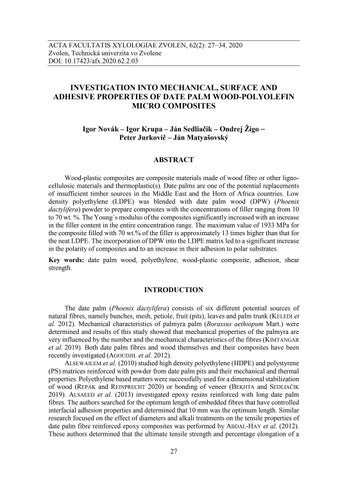ACTA FACULTATIS XYLOLOGIAE ZVOLEN, 62(2): 27−34, 2020 Zvolen, Technická univerzita vo Zvolene DOI: 10.17423/afx.2020.62.2.03
INVESTIGATION INTO MECHANICAL, SURFACE AND ADHESIVE PROPERTIES OF DATE PALM WOOD-POLYOLEFIN MICRO COMPOSITES Igor Novák – Igor Krupa – Ján Sedliačik – Ondrej Žigo Peter Jurkovič – Ján Matyašovský ABSTRACT Wood-plastic composites are composite materials made of wood fibre or other lignocellulosic materials and thermoplastic(s). Date palms are one of the potential replacements of insufficient timber sources in the Middle East and the Horn of Africa countries. Low density polyethylene (LDPE) was blended with date palm wood (DPW) (Phoenix dactylifera) powder to prepare composites with the concentrations of filler ranging from 10 to 70 wt. %. The Young´s modulus of the composites significantly increased with an increase in the filler content in the entire concentration range. The maximum value of 1933 MPa for the composite filled with 70 wt.% of the filler is approximately 13 times higher than that for the neat LDPE. The incorporation of DPW into the LDPE matrix led to a significant increase in the polarity of composites and to an increase in their adhesion to polar substrates. Key words: date palm wood, polyethylene, wood-plastic composite, adhesion, shear strength.
INTRODUCTION The date palm (Phoenix dactylifera) consists of six different potential sources of natural fibres, namely bunches, mesh, petiole, fruit (pits), leaves and palm trunk (KELEDI et al. 2012). Mechanical characteristics of palmyra palm (Borassus aethiopum Mart.) were determined and results of this study showed that mechanical properties of the palmyra are very influenced by the number and the mechanical characteristics of the fibres (KIMTANGAR et al. 2019). Both date palm fibres and wood themselves and their composites have been recently investigated (AGOUDJIL et al. 2012). ALSEWAILEM et al. (2010) studied high density polyethylene (HDPE) and polystyrene (PS) matrices reinforced with powder from date palm pits and their mechanical and thermal properties. Polyethylene based matters were successfully used for a dimensional stabilization of wood (REPÁK and REINPRECHT 2020) or bonding of veneer (BEKHTA and SEDLIAČIK 2019). ALSAEED et al. (2013) investigated epoxy resins reinforced with long date palm fibres. The authors searched for the optimum length of embedded fibres that have controlled interfacial adhesion properties and determined that 10 mm was the optimum length. Similar research focused on the effect of diameters and alkali treatments on the tensile properties of date palm fibre reinforced epoxy composites was performed by ABDAL-HAY et al. (2012). These authors determined that the ultimate tensile strength and percentage elongation of a 27
















